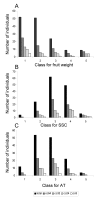A clarified position for Solanum lycopersicum var. cerasiforme in the evolutionary history of tomatoes (solanaceae)
- PMID: 19099601
- PMCID: PMC2657798
- DOI: 10.1186/1471-2229-8-130
A clarified position for Solanum lycopersicum var. cerasiforme in the evolutionary history of tomatoes (solanaceae)
Abstract
Background: The natural phenotypic variability present in the germplasm of cultivated plants can be linked to molecular polymorphisms using association genetics. However it is necessary to consider the genetic structure of the germplasm used to avoid false association. The knowledge of genetic structure of plant populations can help in inferring plant evolutionary history. In this context, we genotyped 360 wild, feral and cultivated accessions with 20 simple sequence repeat markers and investigated the extent and structure of the genetic variation. The study focused on the red fruited tomato clade involved in the domestication of tomato and confirmed the admixture status of cherry tomatoes (Solanum lycopersicum var. cerasiforme). We used a nested sample strategy to set-up core collection maximizing the genetic diversity with a minimum of individuals.
Results: Molecular diversity was considerably lower in S. lycopersicum i.e. the domesticated form. Model-based analysis showed that the 144 S. lycopersicum var. cerasiforme accessions were structured into two groups: one close to the domesticated group and one resulting from the admixture of the S. lycopersicum and S. pimpinellifolium genomes. SSR genotyping also indicates that domesticated and wild tomatoes have evolved as a species complex with intensive level of hybridization. We compiled genotypic and phenotypic data to identify sub-samples of 8, 24, 32 and 64 cherry tomato accessions that captured most of the genetic and morphological diversity present in the entire S. lycopersicum var. cerasiforme collection.
Conclusion: The extent and structure of allelic variation is discussed in relation to historical events like domestication and modern selection. The potential use of the admixed group of S. lycopersicum var. cerasiforme for association genetics studies is also discussed. Nested core collections sampled to represent tomato diversity will be useful in diversity studies. Molecular and phenotypic variability of these core collections is defined. These collections are available for the scientific community and can be used as standardized panels for coordinating efforts on identifying novel interesting genes and on examining the domestication process in more detail.
Figures





Similar articles
-
Variation revealed by SNP genotyping and morphology provides insight into the origin of the tomato.PLoS One. 2012;7(10):e48198. doi: 10.1371/journal.pone.0048198. Epub 2012 Oct 31. PLoS One. 2012. PMID: 23118951 Free PMC article.
-
Genome-wide association mapping in tomato (Solanum lycopersicum) is possible using genome admixture of Solanum lycopersicum var. cerasiforme.G3 (Bethesda). 2012 Aug;2(8):853-64. doi: 10.1534/g3.112.002667. Epub 2012 Aug 1. G3 (Bethesda). 2012. PMID: 22908034 Free PMC article.
-
Genomic variation in tomato, from wild ancestors to contemporary breeding accessions.BMC Genomics. 2015 Apr 1;16(1):257. doi: 10.1186/s12864-015-1444-1. BMC Genomics. 2015. PMID: 25880392 Free PMC article.
-
Domestication and breeding of tomatoes: what have we gained and what can we gain in the future?Ann Bot. 2007 Nov;100(5):1085-94. doi: 10.1093/aob/mcm150. Epub 2007 Aug 23. Ann Bot. 2007. PMID: 17717024 Free PMC article. Review.
-
Molecular breeding of tomato: Advances and challenges.J Integr Plant Biol. 2025 Mar;67(3):669-721. doi: 10.1111/jipb.13879. Epub 2025 Mar 18. J Integr Plant Biol. 2025. PMID: 40098531 Free PMC article. Review.
Cited by
-
High-density SNP genotyping of tomato (Solanum lycopersicum L.) reveals patterns of genetic variation due to breeding.PLoS One. 2012;7(9):e45520. doi: 10.1371/journal.pone.0045520. Epub 2012 Sep 20. PLoS One. 2012. PMID: 23029069 Free PMC article.
-
Fruit Quality Analysis and Flavor Comprehensive Evaluation of Cherry Tomatoes of Different Colors.Foods. 2024 Jun 17;13(12):1898. doi: 10.3390/foods13121898. Foods. 2024. PMID: 38928838 Free PMC article.
-
Variation revealed by SNP genotyping and morphology provides insight into the origin of the tomato.PLoS One. 2012;7(10):e48198. doi: 10.1371/journal.pone.0048198. Epub 2012 Oct 31. PLoS One. 2012. PMID: 23118951 Free PMC article.
-
Multi-Omics Analysis Reveals That SlERF.D6 Synergistically Regulates SGAs and Fruit Development.Front Plant Sci. 2022 Apr 8;13:860577. doi: 10.3389/fpls.2022.860577. eCollection 2022. Front Plant Sci. 2022. PMID: 35463452 Free PMC article.
-
Precision Genome Engineering for the Breeding of Tomatoes: Recent Progress and Future Perspectives.Front Genome Ed. 2020 Dec 15;2:612137. doi: 10.3389/fgeed.2020.612137. eCollection 2020. Front Genome Ed. 2020. PMID: 34713235 Free PMC article. Review.
References
-
- Doebley J, Stec A, Hubbard L. The evolution of apical dominance in maize. Nature. 1997;386:485–488. - PubMed
-
- Frary A, Nesbitt TC, Frary A, Grandillo S, Knaap Evd, Cong B, Liu J, Meller J, Elber R, Alpert KB, Tanksley SD. fw2.2: A Quantitative Trait Locus Key to the Evolution of Tomato Fruit Size. Science. 2000;289:85–88. - PubMed
-
- Buckler I, Edward S, Thornsberry JM. Plant molecular diversity and applications to genomics. Curr Opin Plant Biol. 2002;5:107–111. - PubMed
Publication types
MeSH terms
LinkOut - more resources
Full Text Sources
Molecular Biology Databases

